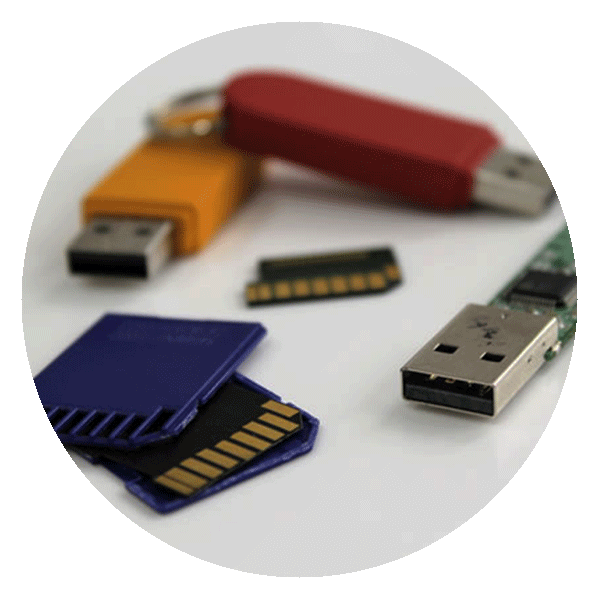FAQ about hard drives not being detected
Below are the most frequently asked questions about hard drives that are not recognised.
My hard disk is not accessible but is recognised by BIOS
If your hard disk is running without problems but is not recognised by your computer's BIOS, this could be a sign of a logical error. This type of failure may be due to faulty media or data damage from another source. In this case, first check the jumpers, which vary depending on the configuration of the hard drive. Also check that the connectors and power supply are properly connected. In severe cases, there may be a problem with the circuit board. In most logical failures, you should be able to recover the data with data recovery software.
My hard drive is not recognised and appears dead
A burnt circuit board (PCB) is one of the most common hard disk drive problems. A power surge, overheating or inadequate power supply can cause a hard drive's spindle driver chip to burn, rendering data inaccessible.
In some older models, you can swap the circuit board from another model. But most modern hard drives have circuit boards adapted to the main drive they are made with. In those cases, a data recovery specialist will need to rebuild or transfer the parameters from the faulty PCB to the donor PCB to make it fully compatible with the damaged hard drive.
My hard drive is not detected by Windows
One of the most common questions we hear is, ‘Microsoft Windows on my PC does not recognise my hard drive. What should I do?’. First, restart your computer, check the connections and connect your external hard drive to another PC. If the problem persists, there could be two reasons:
- The drive is still not recognised by Windows - If you have checked the connections and connected your hard drive to another PC, but it is still not recognised, the hard drive may be faulty.
- The hard disk does not appear in Windows Explorer 10, 7 or 8 but is detected by the computer - There may be a problem with the letter assignment in Disk Management - the hard disk does not have a letter by its name, so Windows Explorer cannot detect the disk partition. Follow these steps to assign a drive letter to it:
- Right-click the workstation icon on your desktop
- Click ‘Manage’ and then ‘Disk Management’ in the Computer Management window
- Select ‘Change drive letter and paths’
- In this window, click ‘Add’ to assign a drive letter to the hard disk partition or click ‘Change’ to change the drive letter.
My hard drive is not detected on my Mac
In this case, you should first check whether your external hard drive is recognised by another system. If you have access to a Windows or Linux PC, connect your external hard drive; if it is recognised, perform a repair from the terminal, you can do this with the commands ‘diskutil list’ and ‘diskutil info disk’. Improper removal of the device may cause damage, so make sure you safely remove the disk before disconnecting the external hard drive.
If the external hard drive is not recognised when you reconnect it to the Mac, first check if your USB cable enables the automatic power function of the USB port. If the hard drive is still not recognised, check whether the ‘Finder’ settings allow you to view newly connected devices. If your hard drive is NTFS formatted and not installed on the Mac, you may need to reset the Read Utility (Paragon NTFS is available in most versions of Mac OS). If the external hard drive is still not readable and not visible in the BIOS of other systems (Windows or Linux), a hardware malfunction should be considered.
Why is my external hard drive not recognised by my MAC?
It could simply be that the USB cable is worn out or that the Mac's utility is misconfigured and does not display connected devices. If the hard drive is not partitioned in HFS+ format, the Mac OS X format or ExFat format, check that the utility is installed correctly. If you have checked all the above, there may be a hardware problem. In that case, contact a data recovery specialist.
How do I access an unrecognised hard drive?
It may seem simple, but swap the USB port and check that your USB cable is working properly. If the hard disk appears in the utility but is not accessible, you need to fix it with the terminal commands. If the hard disk is still not recognised, you may need to use a data recovery software to locate the files.
Is updating drivers a solution?
If your hard drive is detected by your computer but does not show up in Windows Explorer, you can try updating the driver. To do this, follow the following instructions:
- Right-click on the start button and then click on ‘Device Manager’. A coloured indicator may appear in this list to indicate any errors.
- In the ‘Disk Drive’ section, find the reference of your disk. Right-click on it and then click ‘Update driver’. The update will be automatically taken over by Windows Update.
Do I need to format my hard drive?
You should only format your disk if there is no data (or data you don't need) on it. You should choose the right format to suit your computer. Choose NTFS or FAT32 if you use Windows, and HFS+, ExFat or Mac OS Extended if you use Mac.
Remember that formatting a hard drive erases all stored data, so choose this method only if your hard drive is empty.
More about hard disk recovery service


 Great Britain | English
Great Britain | English
 Locations
Locations
 Search
Search




 Back to listing
Back to listing






